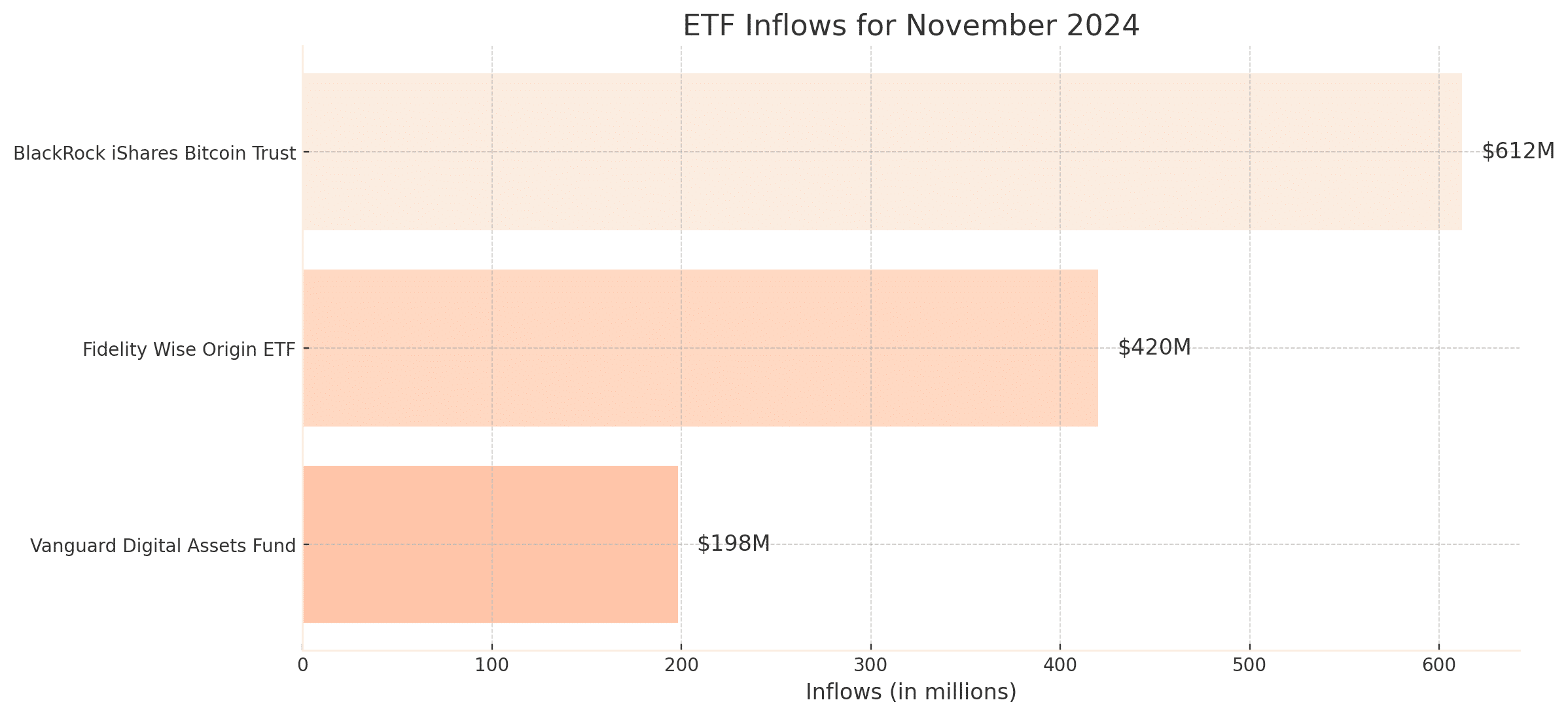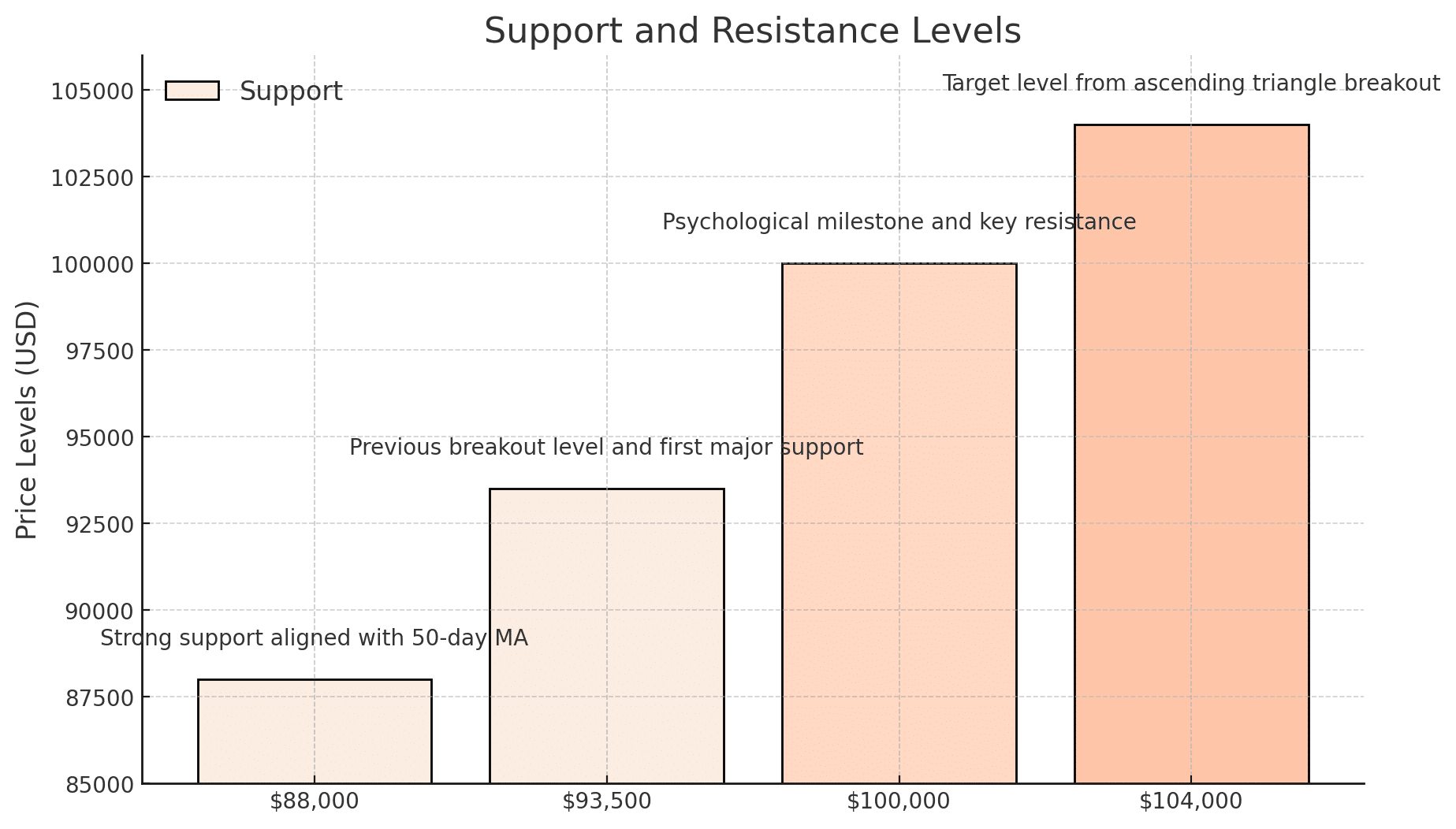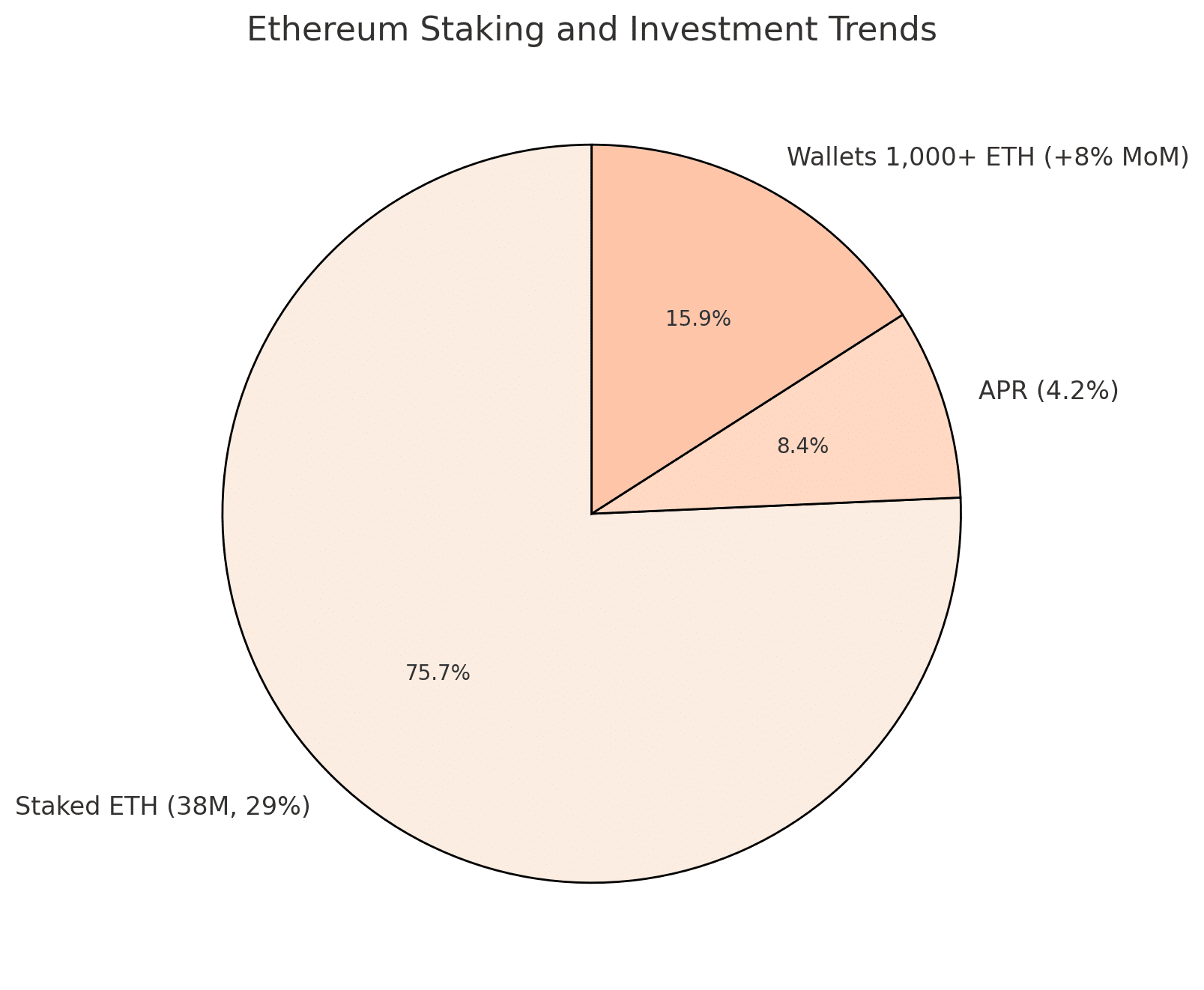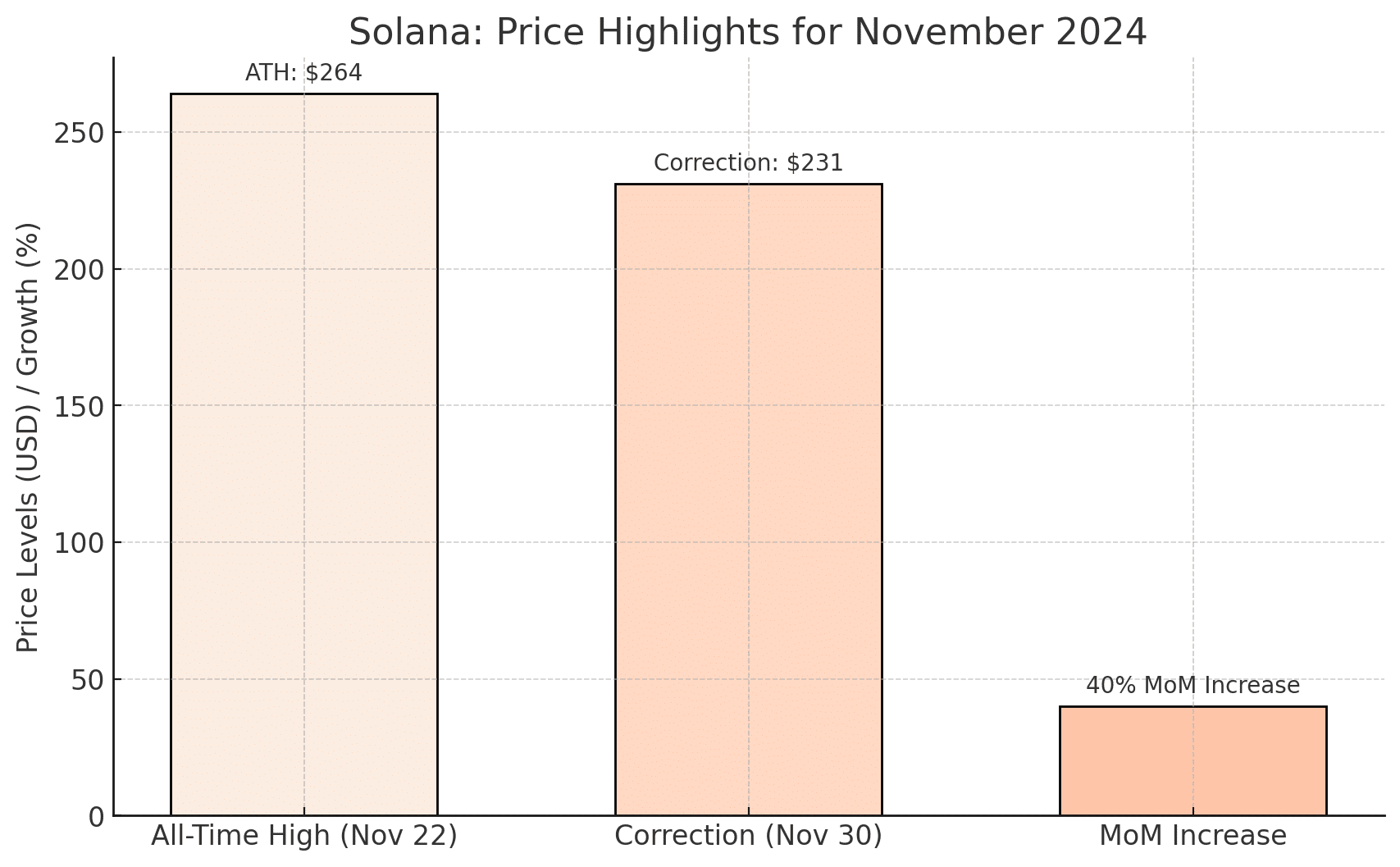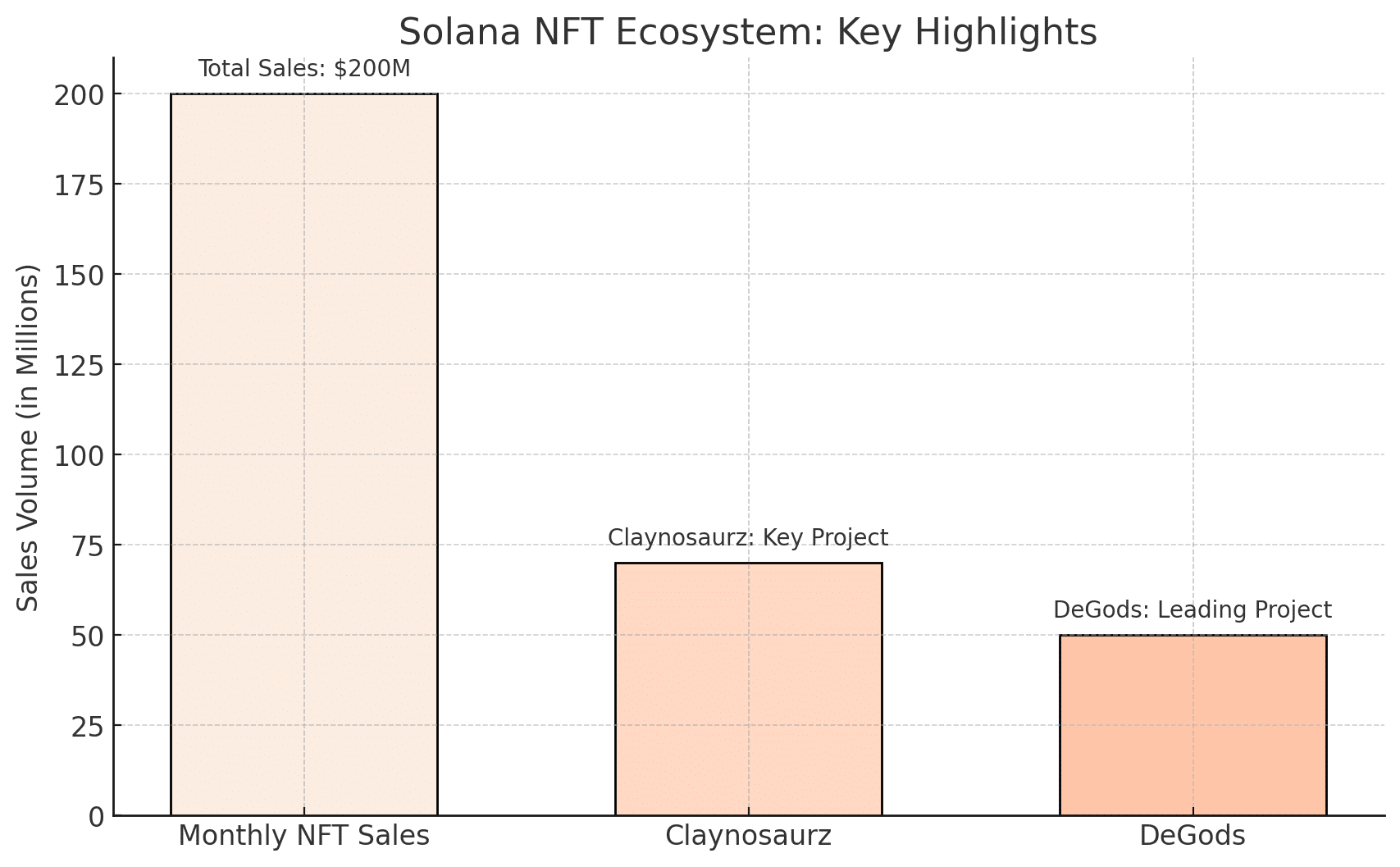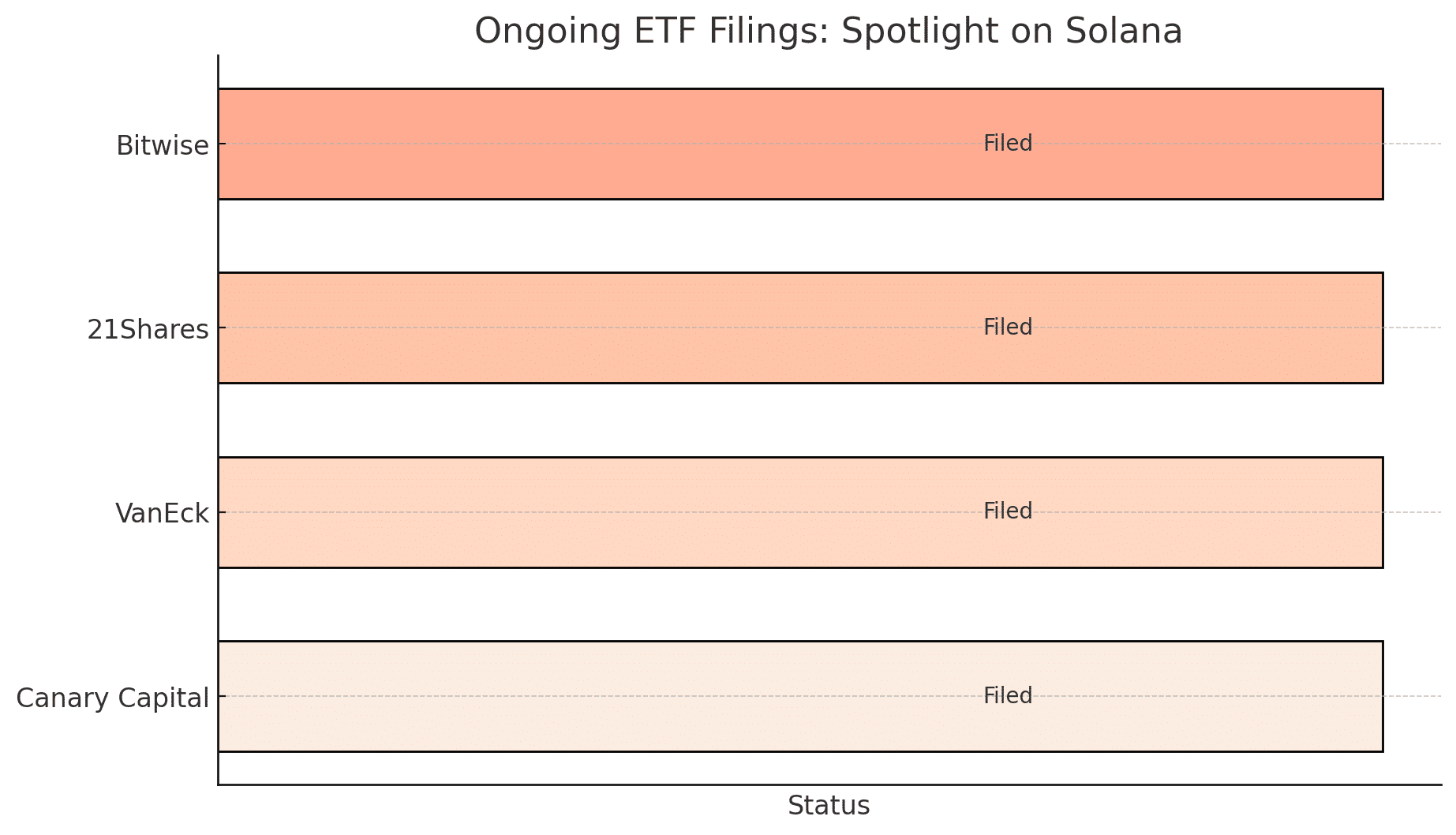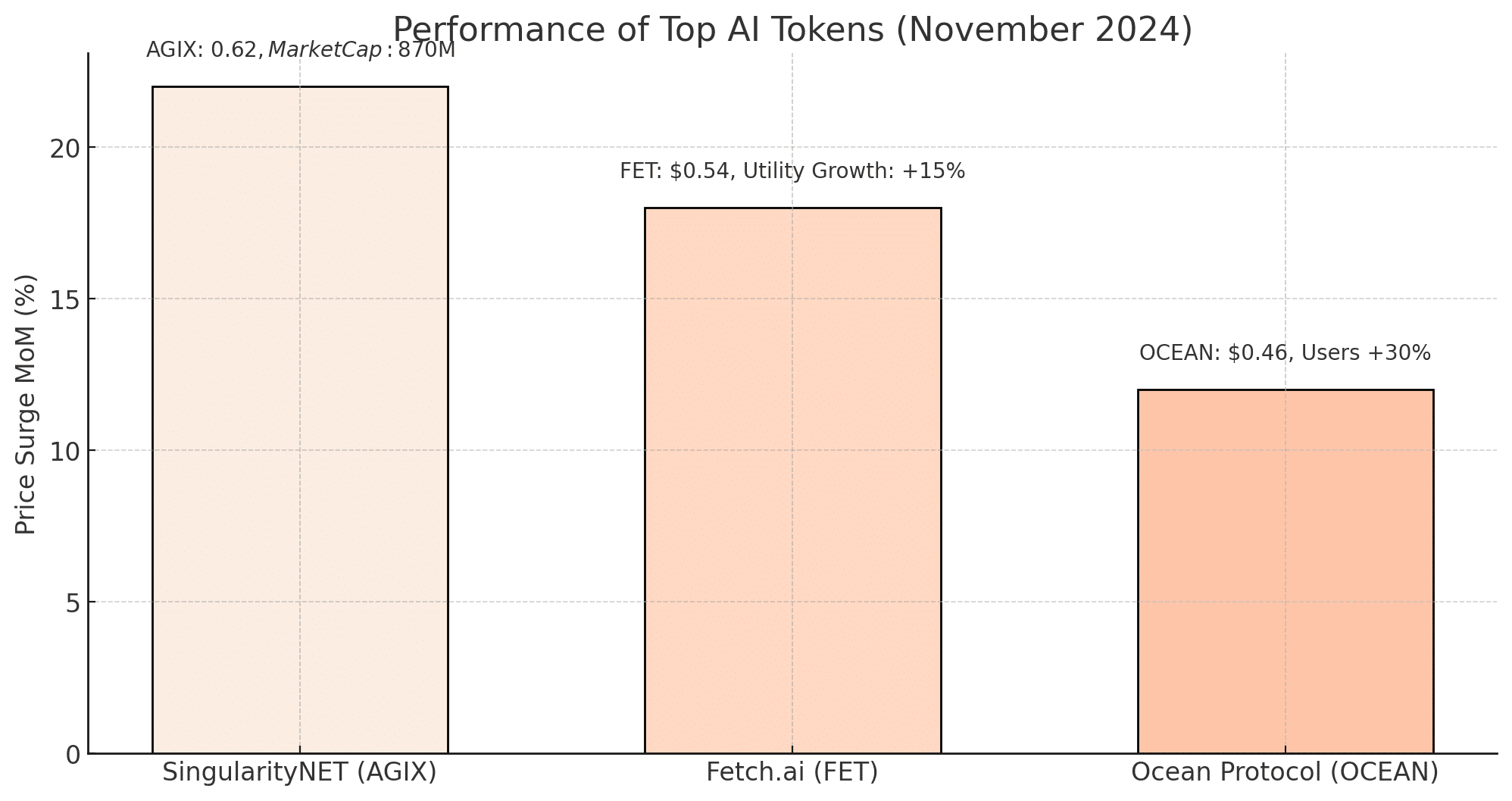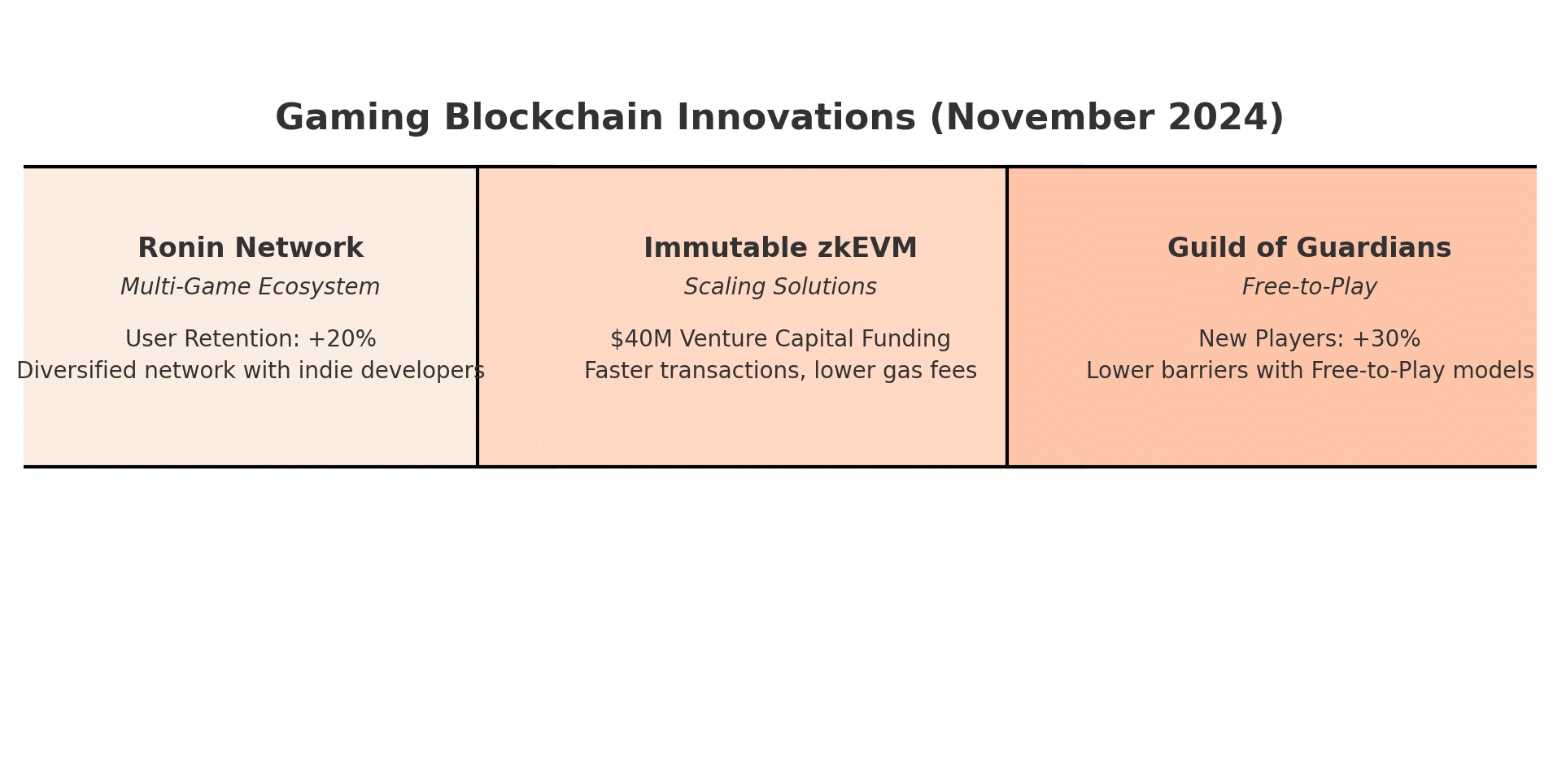Key Takeaways
The cryptocurrency market in November 2024 showcased significant milestones, regulatory shifts, and industry trends. Here are the key takeaways:
Bitcoin ETFs propel institutional adoption
- November marked a turning point as U.S. spot Bitcoin ETFs saw inflows of $2.5 billion, contributing to Bitcoin nearing the $100,000 milestone.
- BlackRock’s iShares Bitcoin Trust led the market, capturing $612 million, while Fidelity’s ETF added $420 million.
- Institutional players now account for an estimated 18% of Bitcoin’s trading volume, highlighting their increasing role in the ecosystem.
Bitcoin’s $100k push sparks profit-taking
- Bitcoin peaked at $99,526 on November 22 before retreating to $91,867 due to long-term holders realizing profits.
- Whale activity surged, with wallets holding over 10,000 BTC accounting for the majority of sell pressure.
- This volatility mirrors 2017’s parabolic rally, though current conditions show stronger institutional support.
Ethereum staking hits a record high
- The total staked ETH surpassed 38 million, representing 29% of Ethereum’s circulating supply.
- Positive staking metrics signal investor confidence in Ethereum’s proof-of-stake model, with staking APRs holding steady at 4.2%.
- Accumulation wallets increased by 15% YTD, reflecting long-term holder optimism.
Solana’s meteoric rise redefines altcoin leadership
- Solana reached an all-time high of $264, fueled by institutional interest and spot ETF filings from major players like VanEck and Canary Capital.
- Its DeFi and NFT ecosystems demonstrated significant growth, with TVL surging and NFT sales exceeding $200 million.
Trump administration’s pro-crypto agenda
- President Trump’s re-election heralded a pro-crypto shift in U.S. policy, emphasizing regulation clarity and the potential approval of more crypto-based financial products.
- Elon Musk’s involvement with the administration amplified Dogecoin’s rally, with DOGE rising 135% in November.
AI tokens surge in popularity
- AI-related tokens like AGIX and FET surged 22% and 18%, respectively, driven by new partnerships and applications.
- The intersection of AI and blockchain is emerging as a key growth sector.
Blockchain gaming addresses player concerns
- Survey data revealed 72% of players believe P2E games prioritize earning over enjoyment.
- Projects like Immutable X and Ronin Network are focusing on improving gameplay to retain users, with daily active wallets up 7% MoM.
NFT market focus shifts from hype to utility
- NFT trading volumes dropped by around 15%, yet utility-based NFTs in gaming and digital identity gained traction.
- Cross-chain innovations, like Stargate Finance’s NFT bridge, are addressing interoperability challenges.
Bitcoin ETFs Fuel Institutional FOMO
November 2024 marked a historic moment in the cryptocurrency market, driven by the increasing influence of U.S.-approved spot Bitcoin Exchange-Traded Funds (ETFs). With inflows reaching $2.5 billion this month alone, these ETFs have significantly transformed Bitcoin’s adoption trajectory. The shift from futures-based ETFs to spot ETFs signals greater confidence among institutional investors and provides a regulated, accessible pathway for traditional finance to engage with Bitcoin.
Breaking down ETF performance
Leading players in the ETF market:
- BlackRock iShares Bitcoin Trust – Captured the largest share with $612 million in inflows.
- Fidelity Wise Origin ETF – Ranked second with $420 million in contributions.
- Vanguard Digital Assets Fund – A newcomer, garnered $198 million despite launching mid-month.
Impact on Bitcoin’s price:
- Bitcoin surged by over 20% MoM, reaching a high of 99,526 on November 22, fueled by increased institutional buying.
- A 35% rise in trading volumes across Coinbase and Binance indicates growing interest from both institutional and retail investors.
What sets spot ETFs apart?
Unlike futures ETFs, spot Bitcoin ETFs track the cryptocurrency’s market price directly, eliminating inefficiencies caused by contango or backwardation in futures markets.
Advantages for institutions:
- Lower volatility compared to futures ETFs.
- Transparent pricing mechanism through direct market tracking.
Regulatory significance:
- The approval of spot ETFs signifies a maturing regulatory stance, providing a green light for hesitant institutional players.
Institutional FOMO: A game changer
The inflow of institutional funds has reshaped Bitcoin’s market dynamics:
- Whale behavior – November witnessed a surge in whale activity, with significant transactions exceeding $1M. This trend reflected renewed interest from large investors, such as hedge funds and asset managers. Reports also indicate a 5% increase in wallets holding 10,000 BTC or more during November, suggesting growing confidence among major holders.

Source: Santiment
- Market sentiment – A Fear & Greed Index score of 81 (Extreme Greed) underscores the bullish market sentiment.
- Corporate treasury adoption – Companies like MicroStrategy added 55,500 BTC to their holdings this month, reinforcing Bitcoin’s role as a treasury asset.
Implications for the crypto industry
- Liquidity boost across ecosystems – The cumulative inflow into Bitcoin Spot ETFs surpassed $30 billion by November 2024. This surge in capital is expected to have a ripple effect, with liquidity likely trickling into other parts of the crypto ecosystem, including DeFi protocols and Layer 2 scaling solutions.


Source: Farside Investors
- Altcoin performance – Historically, strong Bitcoin rallies driven by institutional adoption often lead to lagging performance in altcoins. However, Ethereum’s staking momentum and Layer 2 adoption have helped maintain altcoin resilience this time around.
- Regulatory opportunities – The success of Bitcoin ETFs paves the way for the potential approval of Ethereum spot ETFs in 2025, a move that could expand institutional interest further.
Looking forward: What does this mean for market participants?
- Liquidity opportunities – Bitcoin’s rising prominence through ETFs provides a pathway for investors to channel capital into other parts of the ecosystem, such as DeFi and altcoins.
- Portfolio diversification – Market participants should consider the implications of ETF-driven liquidity on Bitcoin derivatives and altcoin performance.
- Collaborative potential – The regulatory clarity surrounding ETFs opens opportunities for partnerships between crypto platforms and traditional finance institutions, driving cross-sector innovation.
On-chain metrics
Active addresses and network usage:
- The number of active Bitcoin addresses reached 55 million, a 9% increase MoM, signaling heightened participation.
- Transaction volumes hit a monthly peak of $14.2 billion, driven by both retail and institutional activity.
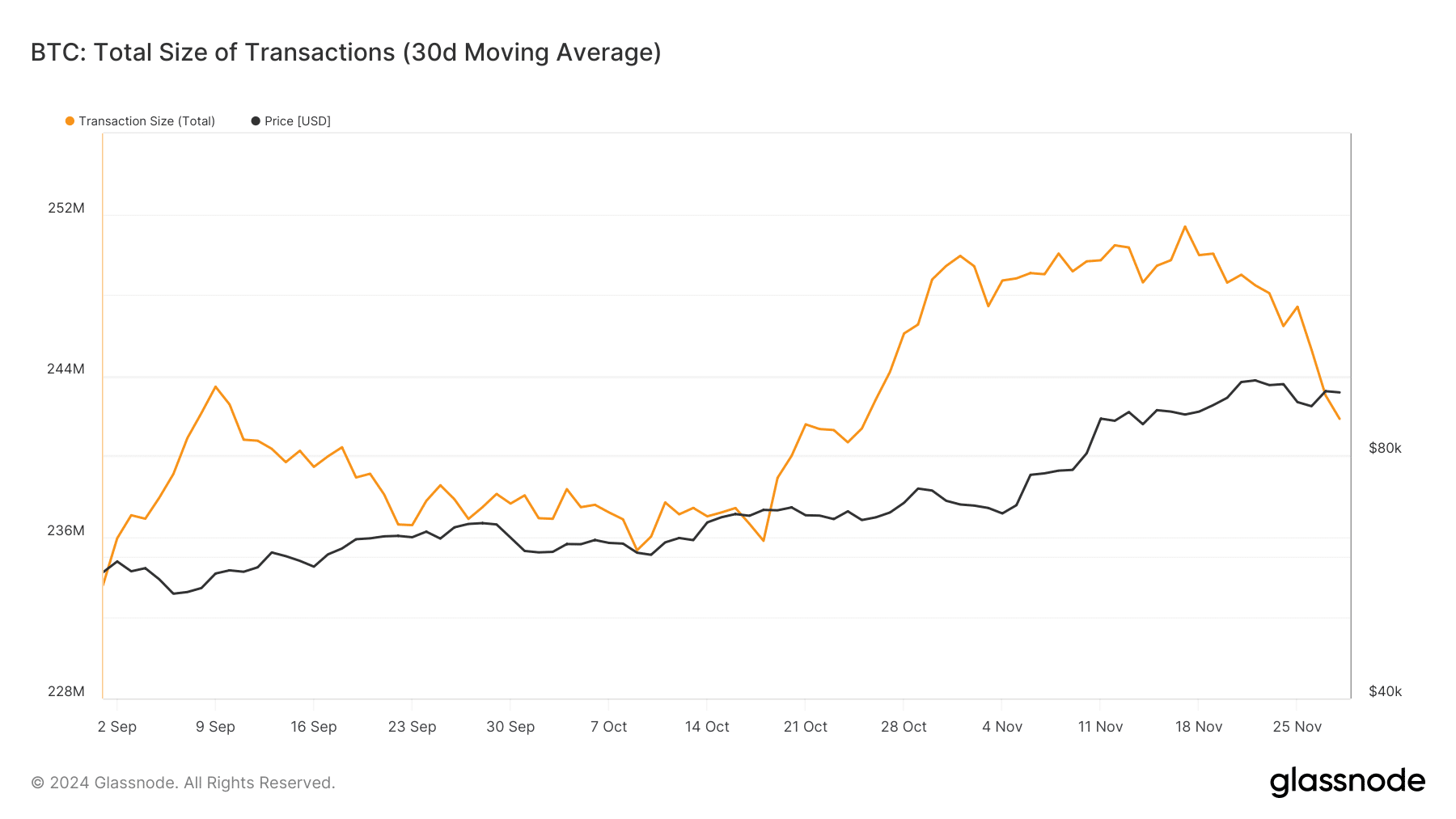

Source: Glassnode
Hash rate and network security:
- Bitcoin’s hash rate climbed to a record 463 EH/s, underscoring miner confidence and network security.
- Miner revenue surged by 15%, reflecting the network’s growing profitability.
What this means for traders and investors
Market strategy adjustments:
- Traders should monitor whale activity and volume trends for signs of continued accumulation or profit-taking.
- Long-term investors may consider dollar-cost averaging to capitalize on Bitcoin’s potential for sustained growth.
Portfolio diversification:
- Bitcoin’s outperformance of traditional assets highlights its role as a hedge against macroeconomic instability.
- Institutional investors may explore Bitcoin ETFs as a regulated entry point into the market.
Bitcoin’s performance in November 2024 reflects the combined impact of macroeconomic forces and on-chain dynamics. With institutional confidence growing and on-chain activity reaching new heights, Bitcoin remains a dominant force in the cryptocurrency landscape. However, cautious optimism is advised as the market approaches the critical $100,000 milestone.
Bitcoin Technicals: The Bullish Flag Unfurled
November 2024 has been a month of technical milestones for Bitcoin, with bullish patterns forming on the charts. A key highlight is Bitcoin’s breakout from a multi-month ascending triangle, signaling strong upward momentum. This section analyzes the technical indicators that defined Bitcoin’s trajectory this month and explores potential scenarios for December.
Key technical patterns
Bullish Flag formation:
- Flagpole formation – The rapid price surge from $82,000 to $99,526 created a textbook flagpole on Bitcoin’s daily chart.
- Consolidation phase – After reaching $99,526, Bitcoin entered a tight consolidation range, forming the “flag” part of the pattern.
- Breakout – On November 25, Bitcoin broke above the $97,500 resistance, confirming the bullish flag formation.
Ascending Triangle breakout:
- A two-month ascending triangle culminated in a breakout above $93,500, a critical resistance level.
- This breakout suggests a potential target of $104,000, aligning with the measured move technique.
Volume and market dynamics
Volume analysis:
- The breakout above $97,500 was accompanied by a 34% spike in daily trading volume, validating the move.
- However, trading volume decreased by 18% during the consolidation phase, reflecting cautious sentiment among traders.
Whale accumulation:
- On-chain data shows a 5% increase in wallets holding 10,000+ BTC, underscoring strong confidence among large investors.
- Whale activity contributed significantly to the breakout above $97,500, as evidenced by a surge in large transactions (>10 BTC).
Key indicators
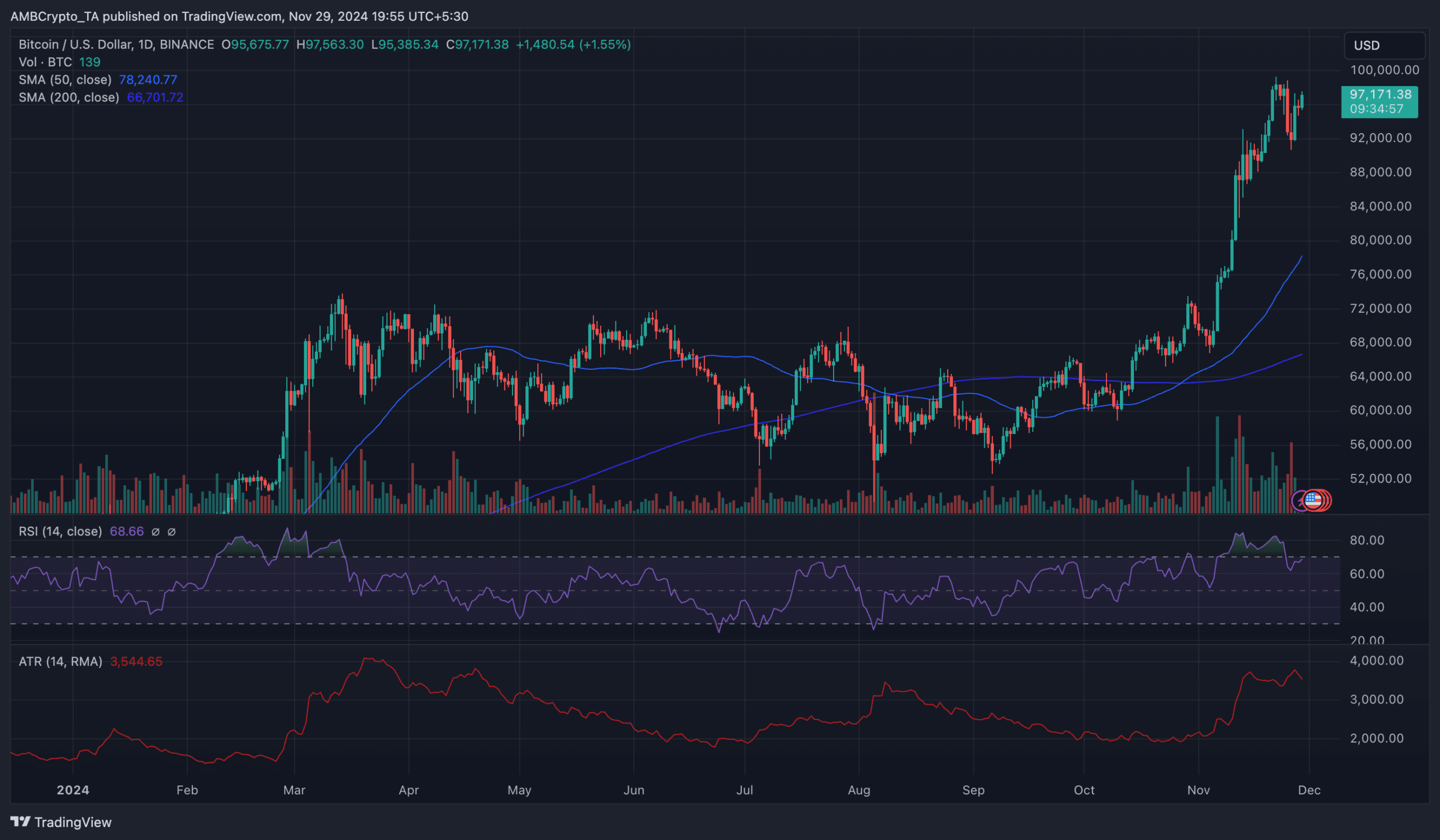

Source: TradingView
Relative Strength Index (RSI):
- RSI on the daily chart peaked at 78, entering overbought territory on November 22.
- The indicator has since cooled to 68, suggesting room for further upward movement without immediate risk of a correction.
Moving Averages:
- The 50-day moving average (MA) at $88,000 provided strong support during Bitcoin’s ascent.
- Bitcoin remains above the 200-day MA at $81,500, signaling a sustained bullish trend.
Average True Range (ATR):
- ATR increased by 20% MoM, reflecting heightened volatility as Bitcoin approached $100,000.
Support and resistance levels
Support zones:
- $93,500 – Previous breakout level and first major support.
- $88,000 – Strong support aligned with the 50-day MA.
Resistance levels:
- $100,000 – A psychological milestone and key resistance.
- $104,000 – Target level derived from the ascending triangle breakout.
Scenarios for December
Bullish case:
- A sustained breakout above $100,000 could attract further institutional interest, pushing Bitcoin toward $110,000 by year-end.
- Indicators such as decreasing RSI and strong on-chain metrics support this scenario.
Bearish case:
- Failure to break $100,000 convincingly could trigger profit-taking, leading to a retest of $93,500 support.
- Increased selling pressure from long-term holders remains a key risk.
What this means for market participants
- Traders – Opportunities lie in riding the bullish momentum, with careful monitoring of resistance at $100,000.
- Investors – Long-term holders should focus on accumulation during dips, particularly near the $88,000–$93,500 support range.
Bitcoin’s technical performance in November underscores its bullish trajectory, with strong patterns and indicators supporting further upward movement. While challenges remain at critical resistance levels, the outlook for December remains optimistic, driven by both technical and on-chain factors.
Ethereum’s Climb: Staking, DeFi, and Upgrades
Ethereum has maintained its position as a leading blockchain network in November 2024, driven by record-high staking participation, significant contributions to the DeFi sector, and anticipation for its next major upgrade. These developments underscore Ethereum’s resilience and adaptability in a competitive crypto landscape.
Record-high staking participation
Ethereum’s transition to proof-of-stake (PoS) continues to strengthen, with staking metrics reaching new milestones:
- Total staked ETH – Surpassed 38 million, accounting for 29% of Ethereum’s circulating supply.

Source: Dune Analytics
- Annual Percentage Rate (APR) – Remained steady at 4.2%, attracting long-term holders seeking passive income.
- Accumulation trends – Wallets holding 1,000+ ETH increased by 8% MoM, signaling confidence from high-value investors.
Impact on market dynamics
- Supply constriction – The increase in staked ETH has reduced liquid supply on exchanges, contributing to price stability.
- Investor sentiment – Positive staking metrics reflect growing trust in Ethereum’s PoS model, positioning it as a preferred choice for institutional and retail investors.
Ethereum’s dominance in DeFi
Ethereum remains the backbone of the decentralized finance ecosystem, contributing to its robust performance:
- Total Value Locked (TVL) – Saw a notable rebound, $69.36 billion at press time, reflecting a 6% increase 6% MoM. This growth is largely driven by activity on Layer 2 networks, which have continued to gain traction.

Source: DefiLlama
- Top DeFi protocols – Lido Finance: Retained its dominance, accounting for 30% of Ethereum’s staked TVL. Aave and MakerDAO: Reported 20% and 15% increases in borrowing activity, respectively, fueled by declining gas fees.
Layer 2 growth
- Solutions like Arbitrum and Optimism saw a combined 15% growth in transactions, underscoring their role in scaling Ethereum.
Anticipation for the ‘Pectra Phase II’ upgrade
Ethereum’s development roadmap remains a critical driver of its market sentiment:
- Upgrade features – Enhanced scalability through zk-rollups. Lower transaction costs by optimizing gas fee calculations.
- Timeline – Scheduled for Q1 2025, with November showcasing early testnet results that exceeded performance expectations.
Potential impact
- User experience – Reduced fees and faster transactions are expected to attract more users to DeFi and NFT platforms.
- Network efficiency – Improved scalability positions Ethereum as a competitive alternative to newer Layer 1 blockchains.
Market performance in November 2024
Ethereum’s price movements mirrored its strong fundamentals:
- Price high – ETH reached a high of approximately $3,427 on November 22, reflecting optimism around staking growth and DeFi activity.
- Support and resistance – Key support: $3,150, bolstered by accumulation wallets. Major resistance: $3,560, aligning with historical sell zones.
- Trading volume – Increased by 18% MoM, with heightened activity on centralized and decentralized exchanges.
What this means for investors and market participants
Staking opportunities:
- Staking remains an attractive option for long-term investors seeking steady returns.
- Projects offering staking-as-a-service can capitalize on Ethereum’s growing demand.
DeFi expansion:
- Ethereum-based DeFi platforms should focus on leveraging Layer 2 solutions to enhance user experiences.
- Institutional interest in DeFi products is expected to rise as Ethereum’s scalability improves.
Upgrade anticipation:
- Market participants should monitor the ‘Pectra Phase II’ upgrade closely, as successful implementation could boost adoption and price action.
Ethereum’s achievements in November 2024 highlight its leadership in staking, DeFi, and network development. With record-high staking participation, growing Layer 2 adoption, and a major upgrade on the horizon, Ethereum is well-positioned to maintain its dominance in the blockchain ecosystem.
Solana’s Breakout Month: The Rise of a Contender
November 2024 marked a defining moment for Solana (SOL), as it solidified its position as a leading altcoin through groundbreaking performance and ecosystem growth. With its price reaching an all-time high of $264, significant institutional interest, and surging decentralized finance (DeFi) activity, Solana has emerged as a formidable contender in the cryptocurrency landscape.
Performance milestones
Price surge:
- Solana hit an all-time high of $264 on November 22 before correcting to $231, reflecting robust market momentum.
- This represented a 40% MoM increase, making it one of the best-performing altcoins during the month.
Market cap and trading volume:
- Solana’s market capitalization surpassed $100 billion in November 2024, firmly securing its position as the fourth-largest cryptocurrency by market value.
- Decentralized exchanges (DEXs) on Solana recorded a monthly trading volume of $115 billion, showcasing its growing prominence in the DeFi space.
- However, while this highlighted Solana’s strength in DEX-specific activity, Ethereum’s total DeFi volume across all protocols and networks remained higher, reflecting its broader ecosystem dominance.
Institutional investment:
- Spot Solana ETF filings by firms like Canary Capital, VanEck, and 21Shares highlight its growing appeal among institutional investors.
- Anticipation around these ETFs contributed to the surge in Solana’s price and trading activity.
Ecosystem growth
DeFi dominance:
- Solana’s DeFi protocols saw substantial growth, with Total Value Locked (TVL) reaching $9.102 billion.

Source: DefiLlama
- Leading protocols like Marinade Finance and Orca experienced 20% and 18% increases in TVL, respectively.
NFT market activity:
- Solana retained its position as the second-largest blockchain for NFTs, with monthly sales volumes crossing $200 million.
- Projects like Claynosaurz and DeGods led the market, driving adoption among collectors and creators alike.
Technological advancements:
- The launch of Solana’s zkSync-powered cross-chain bridge enhanced interoperability, attracting more users to its ecosystem.
- Solana’s transaction speeds and low fees continued to outpace competitors, solidifying its reputation for scalability.
Drivers behind Solana’s success
- Scalability and speed – With an average transaction time of 400 milliseconds and costs as low as $0.00025, Solana remains one of the most efficient blockchains.
- Institutional adoption – The wave of spot ETF filings and strategic partnerships, including collaborations with Polygon Labs, positioned Solana as a key player in institutional portfolios.
- Community engagement – A renewed focus on developer incentives and hackathons led to a 15% increase in active developers, strengthening the ecosystem’s foundation.
Opportunities and challenges
Opportunities:
- Expanding institutional interest in Solana ETFs could channel significant liquidity into its ecosystem.
- Innovations in gaming and DeFi present avenues for continued adoption and growth.
Challenges:
- Solana’s reliance on centralized validators has raised concerns about network decentralization.
- Competition from Layer 2 solutions and emerging Layer 1 blockchains remains a significant hurdle.
What this means for traders and investors
For traders:
- Solana’s volatility and liquidity make it an attractive asset for short-term trading opportunities.
- Spot ETFs, if approved, could drive further price increases, offering a potential entry point.
For long-term investors:
- Solana’s growing ecosystem and technological advantages provide a strong case for long-term investment.
- Monitoring ETF developments and ecosystem growth will be critical for portfolio decisions.
Solana’s breakout performance in November 2024 underscores its potential as a dominant force in the cryptocurrency market. With record highs in price, trading volume, and ecosystem adoption, Solana is poised to redefine its role in the blockchain space. For market participants, aligning with its growth trajectory could yield substantial rewards in the months to come.
Trump’s Pro-Crypto Governance: Shaping the Future of Digital Assets
Donald Trump’s re-election in 2024 has ushered in a pro-crypto agenda aimed at fostering innovation and regulatory clarity. This shift has bolstered the cryptocurrency market, driving institutional participation and expanding the scope of digital asset investment vehicles. A key development has been the wave of spot Bitcoin and Solana ETF filings with the U.S. Securities and Exchange Commission (SEC), reflecting the growing interest in regulated crypto products.
Key policy announcements
Ending the crypto crackdown:
- The administration has pledged to replace adversarial regulatory approaches with collaborative guidelines.
- Agencies like the SEC and CFTC are being encouraged to work alongside industry participants to foster innovation and ensure compliance.
Spot ETFs – Catalysts for institutional growth:
- November saw significant progress in the ETF landscape, with spot Bitcoin ETFs achieving inflows of $2.5 billion.
- Ongoing filings – Canary Capital initiated a spot Solana ETF filing on October 30, 2024, joining VanEck, 21Shares, and Bitwise, which had earlier submitted applications. These filings signal increasing demand for diversified, regulated exposure to cryptocurrencies like Solana.
- With the anticipated resignation of SEC Chair Gary Gensler in January 2025 and the administration’s crypto-friendly policies, the approval process for these ETFs is expected to accelerate.
Tax incentives for blockchain startups:
- To position the U.S. as a hub for blockchain innovation, the administration has introduced tax incentives and funding programs targeting blockchain research and development.
Focus on private sector solutions over CBDCs:
- The administration has opposed Central Bank Digital Currencies (CBDCs), citing concerns over privacy and potential state overreach.
- Instead, the focus remains on empowering private stablecoin projects and decentralized solutions.
Market impact
Bitcoin and institutional inflows:
- Spot Bitcoin ETFs have catalyzed Bitcoin’s price surge, with inflows driving the cryptocurrency to a peak of $99,526 in November.
- Institutional interest in similar products, including Solana ETFs, underscores the shift toward broader digital asset adoption.
Altcoins and diversification:
- Filings for spot Solana ETFs reflect growing confidence in altcoin projects. If approved, these ETFs could channel significant capital into Solana and its ecosystem.
Dogecoin’s resurgence:
- The Trump-Musk association and policy shifts have fueled a 135% increase in Dogecoin’s value, as retail interest reignited across major exchanges.
Challenges and criticisms
- Balancing favoritism and fairness – Critics warn that regulatory clarity should not disproportionately benefit large institutions while sidelining smaller crypto projects.
- Global competitiveness – With Europe and Asia advancing comprehensive regulatory frameworks, the U.S. must act decisively to retain its edge in crypto innovation.
Opportunities for market participants
Leveraging spot ETFs:
- Traders and investors can capitalize on the growing accessibility of crypto ETFs, particularly as new filings expand into altcoins like Solana.
- Spot ETFs provide a simplified and regulated avenue for institutional and retail participation in digital assets.
Startups and enterprises:
- Tax incentives and federal funding present opportunities for blockchain startups to innovate within a supportive environment.
- Projects focusing on Layer 2 solutions, DeFi, or tokenized real-world assets can benefit from clearer regulatory guidelines.
The Trump administration’s pro-crypto governance is shaping the U.S. cryptocurrency market by fostering innovation, attracting institutional capital, and expanding investment opportunities. The influx of ETF filings, including those for Solana and Bitcoin, highlights the evolving landscape. With regulatory clarity on the horizon, the U.S. is poised to solidify its position as a global leader in digital assets.
The Role of AI Tokens in Reshaping Web3 Narratives
Artificial Intelligence (AI) is rapidly becoming a cornerstone of innovation within the blockchain ecosystem. In November 2024, AI-focused tokens surged in popularity, driven by partnerships, real-world applications, and increasing institutional interest. These tokens are bridging the gap between blockchain technology and AI, positioning themselves as key players in the Web3 landscape.
Performance of top AI tokens
SingularityNET (AGIX):
- Price surge – AGIX gained 22% MoM, reaching $0.62 by November 26.
- Market cap – It had a market cap of approximately $870 million.
Fetch.ai (FET):
- Utility growth – FET recorded a 15% increase in daily transactions, reflecting growing adoption in automated logistics and smart cities.
- Price movement – Up 18% MoM, closing at $0.54.
Ocean Protocol (OCEAN):
- Data monetization – OCEAN’s data-sharing marketplace saw a 30% increase in active users, fueled by demand for privacy-preserving data solutions.
- Price action – Rose 12% MoM, reaching $0.46.
Drivers behind the AI token surge
Integration with real-world use cases:
- AI tokens are increasingly being used in industries such as healthcare, supply chain management, and decentralized finance (DeFi).
Institutional interest:
- Venture capital funding for AI-blockchain projects reached $3.2 billion in 2024, reflecting growing confidence in this sector.
- Partnership highlights – SingularityNET’s collaboration with Tenstorrent to develop advanced AI and AGI hardware has positioned it as a leader in decentralized AI training.
Market sentiment and innovation:
- AI tokens benefited from a bullish crypto market, with a 10% increase in trading volumes across major exchanges like Binance and Coinbase.
- New developments – Ocean Protocol’s launch of AI-enhanced privacy tools has expanded its appeal among enterprise clients.
Challenges and opportunities
Scalability and interoperability:
- Many AI-focused blockchains face challenges in handling large datasets and integrating with existing infrastructure.
- Opportunity – Layer 2 solutions and partnerships with cloud providers can address these scalability issues.
Regulatory uncertainty:
- As governments tighten regulations around AI and data privacy, compliance will be critical for long-term growth.
- Example – Ocean Protocol’s focus on GDPR compliance has made it a preferred choice for European enterprises.
Token utility and adoption:
- Projects must demonstrate tangible use cases for their tokens to sustain growth.
- Opportunity – Expanding token utility into DeFi and gaming ecosystems can enhance adoption.
What this means for traders and investors
Growth potential:
- The intersection of AI and blockchain represents a high-growth sector, with AI tokens outperforming most altcoins in November.
- Investors should monitor partnerships and real-world applications to identify long-term winners.
Risk management:
- Given their volatility, AI tokens may experience sharp corrections. Diversification and careful entry points are advised.
AI tokens are reshaping the Web3 narrative by bringing real-world utility to blockchain technology. As adoption grows across industries, these tokens have the potential to redefine how decentralized ecosystems interact with AI. For traders and investors, the focus should remain on projects with strong partnerships, innovative applications, and a clear regulatory roadmap.
Blockchain Gaming Insights: Playability and Profits
Blockchain gaming continues to solidify its role in the Web3 ecosystem, addressing criticisms of prioritizing profits over playability. November 2024 witnessed notable advancements as projects focused on enhancing gameplay experiences, while adoption metrics highlighted the sector’s resilience. This section explores key trends, case studies, and market performance within the blockchain gaming landscape.
Advancements in playability
Player-centric game design:
- Projects like Guild of Guardians introduced story-driven campaigns, earning praise for their engaging narratives.
- Gods Unchained reported a 25% increase in daily active users (DAUs) after launching a new competitive mode, reinforcing the importance of dynamic gameplay.
Balancing rewards and engagement:
- Developers are shifting toward models that balance financial incentives with gameplay.
- Axie Infinity’s revamped tokenomics in November led to a 15% increase in DAUs, as rewards became tied to skill and progression rather than repetitive tasks.
Market performance and metrics
Daily Active Wallets (DAWs):
- Blockchain gaming attracted an average of 4.6 million DAWs in November, up 7% MoM, driven by increased activity on platforms like Ronin and Immutable X.
Gaming token performance:
- ApeCoin (APE) surged 18%, reflecting renewed interest following the announcement of its bridge integration with Layer 2 networks.
- Immutable X (IMX) saw a 12% price increase, fueled by the growth of its NFT ecosystem.
Revenue trends:
- The gaming sector contributed 30% of total NFT trading volume, equivalent to $216 million, underscoring its role in sustaining NFT markets.
Key case studies
Ronin Network – Expanding beyond Axie:
- Ronin introduced a multi-game ecosystem, increasing user retention by 20%.
- New partnerships with indie developers have diversified the network’s offerings, reducing reliance on a single title.
Immutable zkEVM – Scaling without sacrificing quality:
- Immutable X launched zkEVM-based gaming solutions, enabling faster transactions with lower gas fees.
- This innovation attracted $40 million in venture capital funding, signaling confidence in scalable blockchain gaming infrastructure.
Guild of Guardians – Pioneering Free-to-Play models
- By eliminating upfront NFT purchases, Guild of Guardians lowered entry barriers, leading to a 30% increase in new player registrations.
Challenges facing the sector
Retention vs. acquisition:
- While DAUs are growing, player retention remains a challenge for games lacking depth or replayability.
- Games must prioritize consistent content updates and community engagement to sustain interest.
Cost and accessibility:
- High entry costs and technical barriers still deter mainstream adoption.
- Solutions like embedded wallets and cross-platform compatibility are emerging to address these issues.
Monetization criticism:
- 72% of surveyed gamers feel P2E games prioritize earning over enjoyment, a perception that developers are working to overcome.
Opportunities for growth
- Interoperability across platforms – Projects focusing on cross-platform compatibility, such as enabling players to transfer assets across games, can enhance user experiences and loyalty.
- Integration with AI and VR – Combining AI-driven NPCs and immersive VR experiences offers new avenues for blockchain gaming innovation.
- Expanding DeFi integration – Token staking and liquidity pools tied to in-game economies can attract DeFi users to gaming ecosystems.
What this means for market participants
Investors:
- Focus on utility-driven gaming projects with strong roadmaps and growing user bases.
- Diversify across ecosystems like Immutable X and Ronin to mitigate risks.
Developers:
- Prioritize gameplay improvements to meet player expectations and build long-term sustainability.
- Explore partnerships with traditional gaming studios for broader adoption.
Blockchain gaming is undergoing a transformative phase, balancing profitability with meaningful player experiences. As projects innovate to address accessibility and retention, the sector’s potential to drive Web3 adoption becomes increasingly apparent. For market participants, staying aligned with evolving player preferences and technological advancements will be crucial.
AMBCrypto’s Survey: 5,000+ Gamers Reveal What’s Wrong With Blockchain Gaming (P2E)
Blockchain is pushing the boundaries of what Play-to-Earn (P2E) models can achieve. In November 2024, AMBCrypto conducted an exclusive survey involving over 5,000 participants, shedding light on key challenges and opportunities in this growing sector. The findings reveal a shift in player priorities, with an increasing emphasis on playability and sustainable ecosystems.
Key survey findings
Do P2E games focus more on earning crypto than being fun?:
- 72% of respondents believe that P2E games prioritize earning over delivering an enjoyable gaming experience.
- Players cited repetitive gameplay, lack of narrative depth, and excessive monetization as primary concerns.
- However, 18% of participants expressed optimism, stating that recent improvements in game design are closing this gap.
Do NFTs in games exploit players or add value?:
- 62% of participants feel that NFTs in games are exploitative, often used as profit mechanisms rather than enhancing the player experience.
- Conversely, 28% believe that NFTs offer meaningful benefits, such as ownership of in-game assets and cross-platform functionality.
- 10% remain undecided, viewing the potential of NFTs as dependent on developers’ intentions.
Challenges facing blockchain gaming
Balancing profitability with playability:
- Players are increasingly critical of games that emphasize earning potential over engaging content.
- Developers must innovate to create ecosystems where gameplay and financial incentives coexist harmoniously.
Accessibility and onboarding:
- High entry costs, complex wallet setups, and steep learning curves remain barriers for new players.
- Solutions like embedded wallets and free-to-play models are gaining traction to simplify onboarding.
NFT integration:
- While NFTs offer exciting possibilities, their implementation often feels forced.
- Projects focusing on utility, such as crafting, achievements, or trading cards, are finding greater success.
Opportunities for market participants
- Investing in utility-driven games – Games that prioritize long-term engagement and utility-driven NFTs are better positioned to attract players and investors alike.
- Partnerships with traditional gaming studios – Collaborations between blockchain and traditional gaming companies could bridge the gap between innovation and familiarity.
- Focus on accessibility – Simplifying game mechanics and onboarding processes will be critical in attracting mainstream audiences.
NFT Market Update: Utility vs. Speculation
The NFT market in November 2024 continued its transformation from a speculation-driven space to one emphasizing real-world utility and innovation. While trading volumes declined by 15% MoM, projects focusing on functional NFTs gained traction, highlighting a shift in market priorities.
Performance trends
Declining trading volumes:
- Overall NFT trading volume fell to $235 million, reflecting a decline from October 2024. This decrease is visible in the trading volume data from NFTGo, showing a slowdown in market activity.

Source: NFTGo
- Ethereum-based NFTs remained dominant, accounting for 62% of total sales, despite increased competition from Solana and Polygon.
Platform competition:
- Magic Eden retained the largest market share at 38%, but Blur closed the gap with 26%, driven by aggressive incentive programs.
- Cross-chain solutions like Stargate Finance’s NFT bridge saw a 25% increase in adoption, addressing fragmentation issues.
Emerging collections:
- The DMarket NFT collection surpassed CryptoPunks in sales volume, highlighting a demand for collections tied to gaming ecosystems.
- The most expensive NFT sold in November was an Ordinals collection piece for $4.1 million, underscoring the niche appeal of high-value digital art.
Utility-driven NFTs: A new focus
Real-world applications:
- NFTs are increasingly being used in ticketing, supply chain tracking, and identity verification.
Enterprise adoption:
- Luxury brands and corporations continue to explore NFTs as a tool for customer engagement.
Challenges facing the NFT market
Regulatory scrutiny:
- Governments are tightening regulations around NFTs, particularly in areas like copyright infringement and anti-money laundering (AML).
- Projects must prioritize compliance to maintain legitimacy and avoid penalties.
Accessibility and costs:
- High minting fees and complicated wallet setups remain barriers for mainstream adoption.
- Efforts to reduce gas fees and introduce fiat payment options are underway, but adoption is slow.
Market saturation:
- Oversupply of low-quality collections has diluted market interest, with 68% of survey respondents indicating fatigue with speculative NFTs.
Opportunities for growth
Interoperability and cross-chain integration:
- Platforms focusing on cross-chain solutions can attract users seeking flexibility and broader usability.
- Example – Stargate Finance’s NFT bridge simplifies trading across chains, improving liquidity.
Focus on tangible benefits:
- Utility-driven NFTs tied to gaming, real estate, and memberships are likely to see sustained interest.
- Projects emphasizing community engagement and exclusive access are well-positioned for growth.
AI integration:
- Combining NFTs with AI technologies, such as dynamic NFTs that evolve based on user interaction, can create innovative use cases.
What this means for investors and market participants
Strategic investments:
- Investors should focus on projects that deliver tangible utility, such as gaming NFTs or enterprise-driven collections.
- Diversification across multiple blockchains can mitigate risks associated with platform competition.
Navigating challenges:
- Market participants must stay updated on regulatory changes and prioritize compliance to avoid disruptions.
- Exploring interoperability-focused solutions can open new opportunities for cross-chain investments.
The NFT market in November 2024 reflects a critical pivot toward sustainability and utility. As speculative interest wanes, projects delivering real-world benefits are poised to lead the next phase of growth. For investors and participants, focusing on functional NFTs and cross-chain innovations will be key to staying ahead in this evolving landscape.
References
- Glassnode
- Santiment
- IntoTheBlock
- CryptoQuant
- CoinGecko
- CoinMarketCap
- Messari
- Coinglass
- TradingView
- Dune Analytics
- DeFi Llama
- NFTGo
- SEC Filings Database
- AMBCrypto’s Survey: P2E gaming and NFTs: Still relevant?
Disclaimer — This report analyzes data till November 25, 2024. It aims to provide comprehensive insights into market developments. All data presented is intended for informational and educational purposes. It’s crucial to note that no investment decisions should be made solely based on the information contained within this report. Ultimately, individuals are responsible for their own investment decisions and should conduct thorough research and analysis before making any financial commitments.
Source: https://ambcrypto.com/crypto-market-biggest-movers-of-november-2024/
